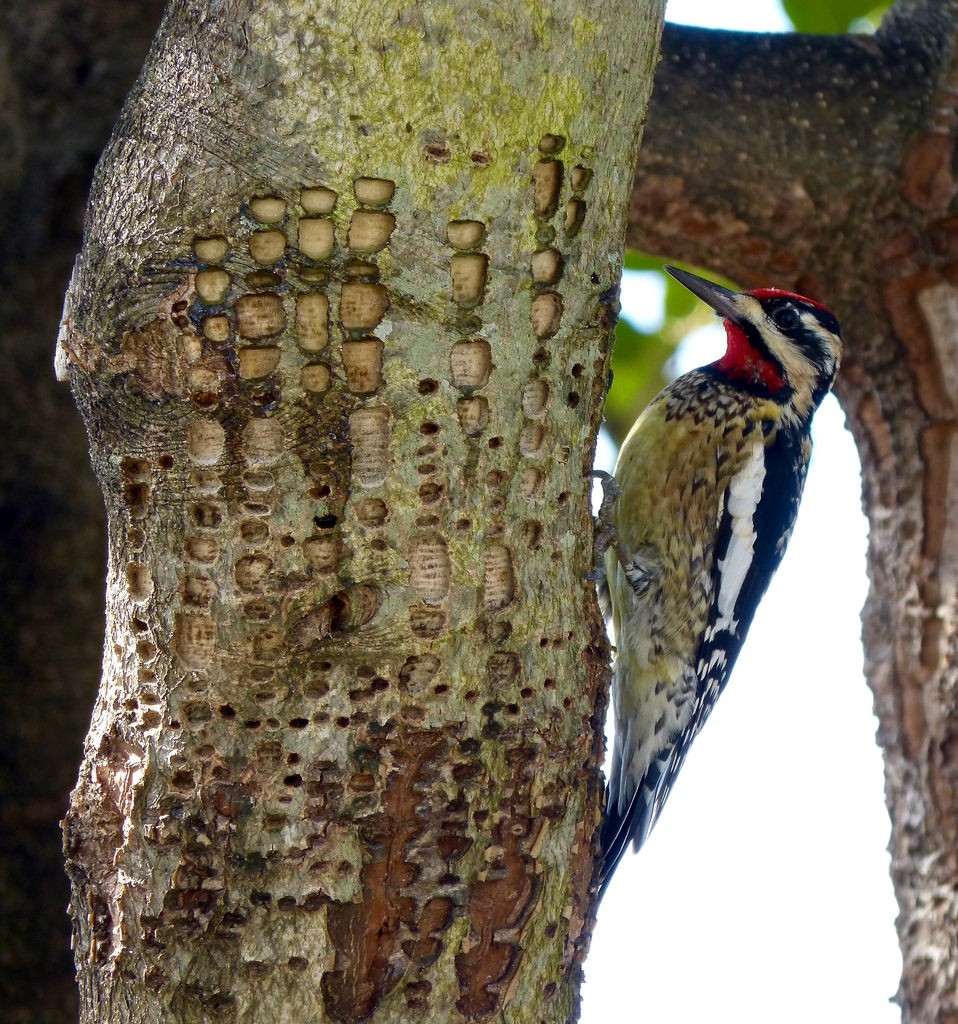By Rick Borchelt

Here in central Maryland, we can see woodpeckers all year long. In College Park, we regularly count on the two small woodpecker lookalikes, Downy (Dryobates pubescens) and Hairy (Leuconotopicus villosus), and their larger cousin Red-bellied (Melanerpes carolinus) to be everywhere in the neighborhood — especially if you have suet feeders out. Red-headed woodpeckers (Melanerpes erythrocephalus) sometimes move right on through, but these woodpeckers are more typical residents of rich, bottomland forests along the Chesapeake Bay. We’re as apt to see northern flickers (Colaptes auratus) on the ground around stumps and anthills as we are in the trees. We’ve even been treated recently to a pair of immense pileated woodpeckers (Dryocopus pileatus) that have been feasting on insect-infested limbs, trunks and stumps of our most mature trees.
But there is one kind of woodpecker that we see only in winter, if we see it at all. What usually tips us off to the presence of this shy bird are rows of precision-drilled holes in tree bark from which sap exudes — this tells us we have a yellow-bellied sapsucker spending the winter with us.
Sapsuckers do exactly what their name suggests: They drill shallow holes and feed on the carbohydrate-rich sap that leaks out. But rich as it is, sap would be a boring and not entirely sufficient diet for a woodpecker. Luckily, the sap has the added benefit of attracting insects to feed on the sugary stuff. The sapsucker feeds on these insects, too.

Courtesy of Jim Brighton
North America is home to five species of sapsuckers; only the yellow-bellied is found east of the Mississippi River. These woodpeckers nest in the boreal forests in northern New England and Canada, although occasional nesting pairs can be found in high elevations of the Appalachians, including in far western Garrett County. These robin-sized woodpeckers move south in winter, where temperatures are moderate enough to support sap flow most of the year.
Sapsuckers are pretty particular about the trees they drill for sap. Usually, they pick young, deciduous trees with smooth bark. And often as not, sapsuckers drill for sap, creating a pattern of what we call wells, on the west-facing side of the tree; the afternoon sun warms the bark on this side and encourages sap flow.
The sapsuckers’ wells can be of two kinds, depending on which sap system they’re tapping. They drill deep, circular holes that go into the tree’s xylem system or shallow, rectangular holes that tap into the phloem network, which is closer to the bark’s surface. Sap flows up through the xylem in the spring and summer from the tree’s roots to its budding leaves; the phloem system carries food downward from the leaves to the roots — and there’s usually sap in the phloem all year long. When it’s really cold, though, the phloem system freezes up, but in the warmth of afternoon winter sun it thaws, and sap accumulates in the wells.
Local sapsuckers prefer to drill wells in beech, birch, elm and maple. They’re also fond of orchard trees like apples, crabapples, plums and cherries. Sapsucker wells seldom damage the trees they’re drilled in, and in any event, the wells heal over during the summer, when the sapsuckers are away doing family duty. You can see the results of sapsucker wells that were drilled decades ago; on these older trees, the pattern looks more like complicated Morse code messages from birds long dead.
Sapsuckers usually pick a dozen or so trees in their winter territory to drill their well fields. They spend their days moving from one tree to the next, drilling and expanding the wells so the sap keeps flowing. But you won’t see the industrious birds themselves unless you look carefully. Sapsuckers are bashful creatures, unlike the loud and boisterous members of the woodpecker clan we’re used to seeing and hearing. Their tapping is soft, and their call sounds more like a complaining meow from a cat than it does a bird call. When they are spotted, sapsuckers take great care to keep the trunk of the tree between themselves and their observers, flying away if you get too close.
In recent years, naturalists have noted just how important sapsucker wells are to other animals in winter. Chickadees, nuthatches, kinglets and even overwintering warblers get a lot of nutrition from the sap in sapsucker wells, which can be as much as 10% sugar. Bats and squirrels, including flying squirrels, also visit the wells for an energy boost. And come spring, the region’s first butterflies and north-bound migrating birds depend on the sap flowing up through the xylem. Even hummingbirds get in on the act as they migrate through.
Walk the neighborhood on a warm winter’s day, and you’re sure to see one or more well trees. If you’re lucky, you might also see the wildcatter drilling the wells, a yellow-bellied sapsucker — if it doesn’t see you first!
—
Have questions for Rick about the world of nature in and around the city, or suggestions for future College Park Wild columns? Drop him a note at rborchelt@gmail.com.







